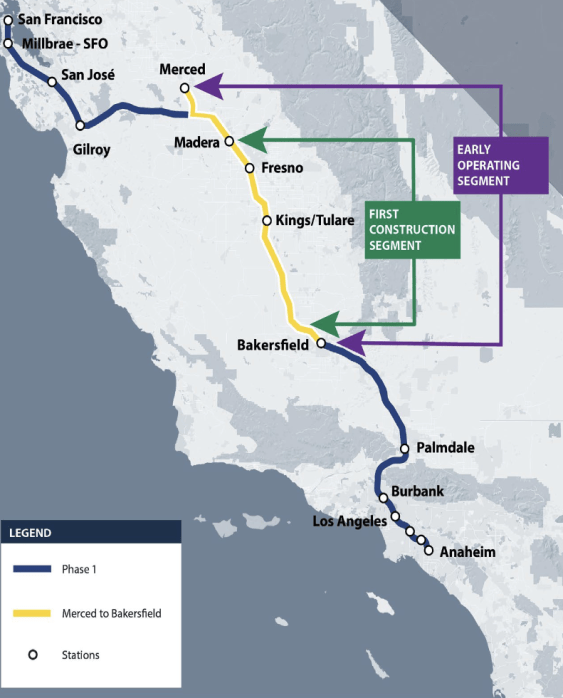Applying the Parklet Strategy to Make Transit Stops Better, Quicker
4:04 PM PDT on May 20, 2015
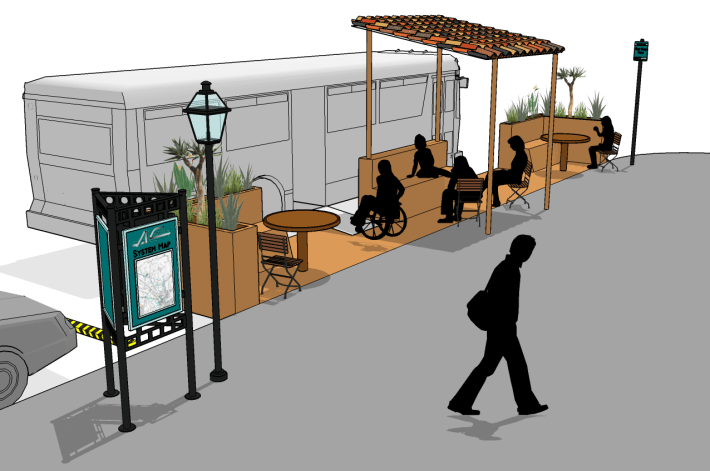
San Francisco's parklet revolution has broadened the possibilities for how curb space can be used. Now, city planners in SF and the East Bay are taking the idea in a new direction: using temporary sidewalk extensions to make transit stops more efficient and attractive.
Three different names for the concept have emerged from planners at three institutions where it was conceived independently -- "temporary transit bulbs," "multi-purpose parklets," and "stoplets." Those terms come from, respectively, SF transportation agencies, Alameda-Contra Costa Transit, and Ben Kaufman, a graduate student at the UCLA Department of Urban Planning.
Whatever you call it, the method could allow transit agencies to much more rapidly implement transit bulb-outs -- sidewalk extensions at transit stops -- and reap the benefits at about one-twentieth the cost of pouring concrete, on average, according to Kaufman.
For his UCLA graduate project, Kaufman is wrapping up a stoplet design guide for AC Transit, which received a Safe Routes to Transit grant to study the idea.
Kaufman sees stoplets as a way to re-invent the bus stop. "Why can't we create a space that people actually want to sit at, that would make people excited to wait for a bus?" he said. "Instead of being a waiting experience, it can be a relaxing experience." Like parklets, stoplets would be "adopted" by merchants who want to improve bus stops in front of their storefronts.
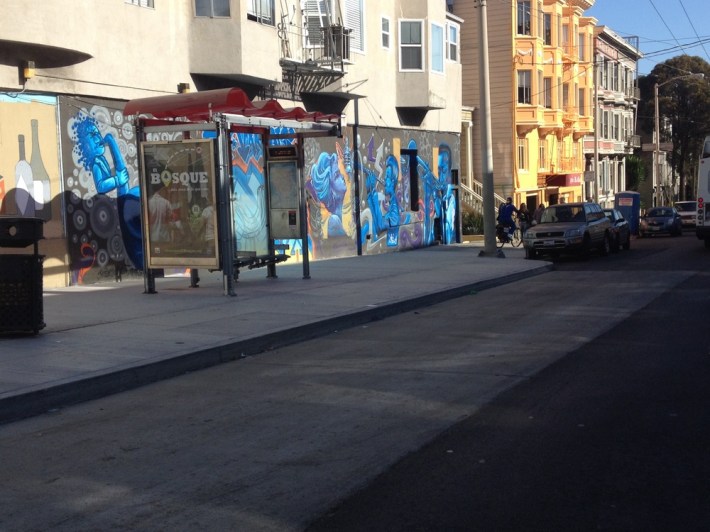
Kaufman, a former SF resident and organizer with the SF Transit Riders Union, presented the idea to SFMTA staff during a summer internship last year with the Muni Forward program (then known as the Transit Effectiveness Project). Stoplets didn't gain traction with Muni, but he later connected with an AC Transit planner who had the same idea.
In SF, meanwhile, the Planning Department and SF County Transportation Authority are leading a pilot "temporary transit bulb" program with the SFMTA that could put projects on the ground this year.
Unlike stoplets, SF's transit bulbs would be built by the city at stops where they're needed most to speed up transit boardings. Their primary purpose would not be to act as attractive gathering spaces, but purely to improve the waiting and boarding experience at transit stops, said Robin Abad Ocubillo, parklet manager for the Planning Department's Pavement to Parks program.
"These installations are somewhat based on the parklet typology, but with significant changes to serve the performance needs associated with transit vehicles and users," said Ocubillo. "The new pilot installations would extend the sidewalk to create more ample waiting and boarding areas, provide more efficient boarding and alighting for passengers -- especially those who need the deployable ramp [compliant with the American Disabilities Act], and potentially introduce more amenities for transit users."
Transit bulb-outs make the bus ride faster and more comfortable by eliminating the need for buses to weave in and out of traffic when making stops. The bulbs also provide more room to wait on narrow sidewalks and keep passengers out of the path of people walking by.
By using temporary materials, transit agencies could avoid the relatively high costs and time-consuming construction schedules of concrete sidewalk extensions.
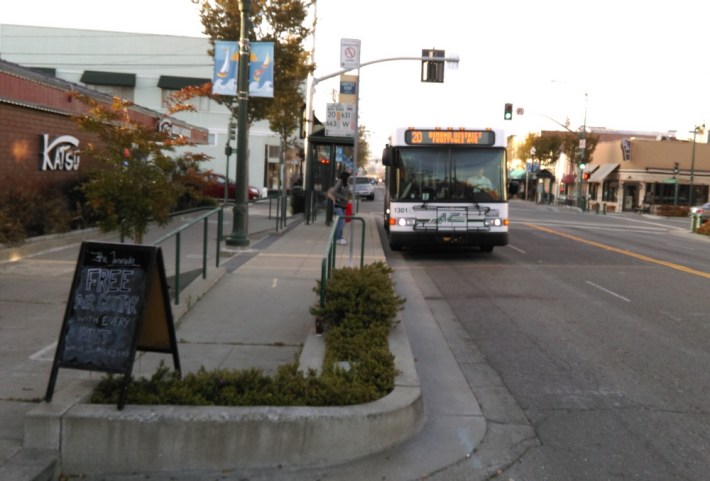
According to Kaufman, each concrete transit bulb costs AC Transit an estimated $633,000. At Muni, he said construction costs alone were between $200,000 and $500,000, depending on what utility infrastructure needed to be moved. Parklets and stoplets, by comparison, tend to cost around $20,000, and they don't interfere with drainage since they're propped up over curb gutters.
Transit bulbs are a key component of the Muni Forward program in SF, where they're sprouting up along more routes. Typically, SF's bulbs are a simple curb extension with a bus shelter. In Oakland and Alameda, AC Transit recently installed bulbs with features like curbs raised above sidewalk height to allow for level bus boarding, as well as greenery along its 51 route.
At least two Oakland merchants want to install parklets at bus stops in front of their storefronts, said Stephen Newhouse, who manages AC Transit's "multi-purpose parklet" project. The agency is still shaping details like the appropriate share of construction costs merchants should shoulder, if any.
Under Kaufman's vision, merchants would take stewardship for stoplets, but the city would pay for construction, which he said would allow more merchants to bring parklets to low-income communities. So far, parklets tend to be built in affluent neighborhoods where merchants can pay the up-front costs.
Neglected bus stops, added Kaufman, would also be better maintained by merchant stewards than they have been by Clear Channel, which maintains transit shelters in SF and other cities in exchange for advertising space.
"To be able to create this opportunity for low-income communities and businesses, I think, is a pretty big selling point," said Kaufman.
Newhouse noted that parklets seem to gain political support more easily than improvements like traditional bus bulbs when replacing curbside car parking. And by consulting the creativity of merchants and residents in stoplet designs, Kaufman said, planners could experiment and help "create new paradigms of what makes a good bus stop."
AC Transit even enlisted Berkeley High School students this semester in a partnership with UC Berkeley's Y-Plan program, which brings urban planning classes to schools around the world.
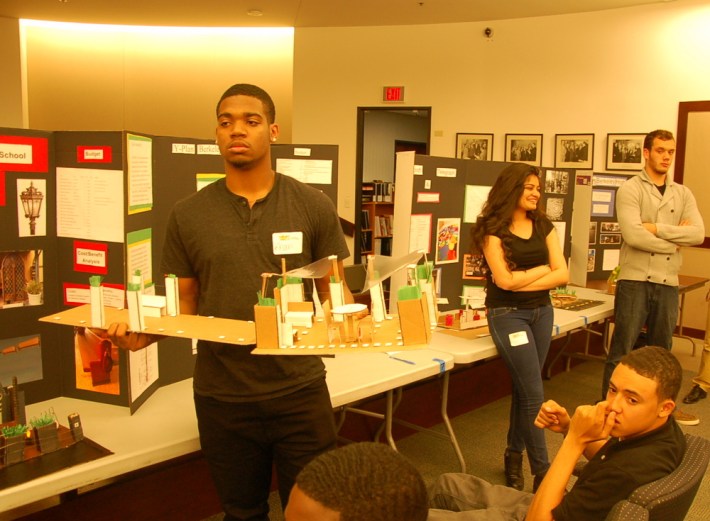
The Berkeley High class created concept designs for stoplets at eight existing bus stops in Berkeley, conducting on-street surveys in the process. Groups presented their designs late last month to a panel comprised of an AC Transit Board member, an architect, and Berkeley's Bay Area Bike Share coordinator.
Students are "users of the system," said Newhouse, "and they have flexible notions of what a bus stop can be."
In SF, the first few "temporary bus bulbs" will go in at a Potrero Hill public housing site that is poised for redevelopment in the coming years. The idea emerged in the Potrero Hill Neighborhood Transportation Plan as a way to create more public space in a long-neglected neighborhood. Since the streets will be redeveloped in the near future, temporary installations made the most sense, said SFCTA senior planner Michael Schwartz.
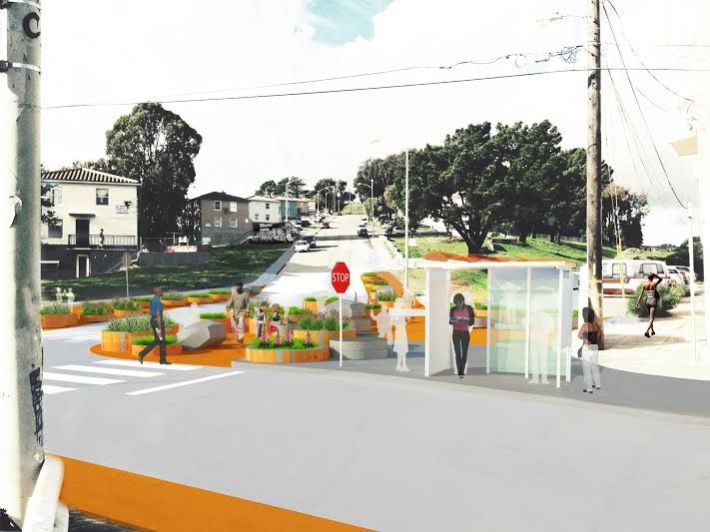
BRIDGE Housing will be responsible for maintaining the Potrero bus bulbs and other temporary sidewalk expansions, said Schwartz. The spaces will include amenities like greenery, seating, and lighting that wouldn't likely be part of temporary transit bulbs if expanded citywide.
"Rolling them out citywide is a different question," said Schwartz.
"When we think about what parklets do, and their morphology," added Ocubillo, "they have a whole different function" than bus bulbs. "Blending them would be an interesting question, but right now, there it would also be very complex from a liability and management standpoint."
As the various "stoplet"-like programs emerge, Kaufman said, "With all the minds coming together, I think there'll be a model for success."
While SF's program could go a long way toward improving Muni, Kaufman said there are important benefits to be gained from the approach of letting merchants create parklets. "It lets them get excited about the bus stop and feel obligated to it," he said, and provides an "activated" gathering space that attracts "eyes on the street."
"To create that relationship between a bus stop and a small business, I think, will change the ball game."
Read More:
Stay in touch
Sign up for our free newsletter



